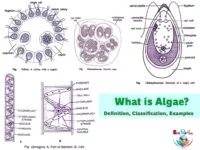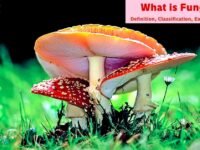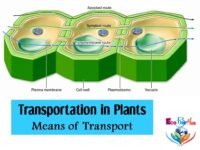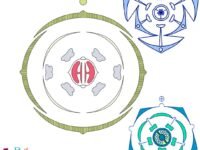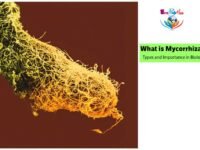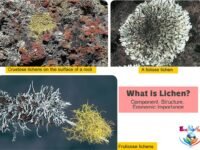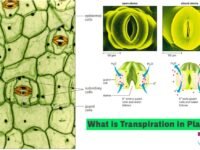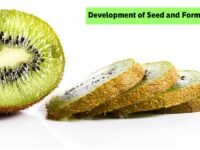In this tutorial, we have discussed ‘what is lichen’, ‘components of the lichen’, ‘structure of lichens’, ‘lichen examples with their economic importance’ and many more.
The study of lichens is called lichenology.
TABLE OF CONTENTS
What is Lichen
— A lichen is a symbiotic association of one or more fungi and a photoautotroph (either a green alga or a cyanobacterium). Such a mutually beneficial relationship is called symbiosis or mutualism.
—The fungal member of the lichen is called mycobiont and the photosynthetic partner (algae or cyanobacterium) is called photobiont or phycobiont. Mycobiont usually makes up about 90% of the whole and the other 10% by the photobiont. The two organisms live in close association with each other so much so that they appear to be a single organism.
— In 98% of the lichens, the mycobionts or fungal partners belong to ascomycetes. In the remaining, the fungal partners belong to basidiomycetes and deuteromycetes.
— Photobionts or phycobionts either belongs to cyanobacteria or green algae.
— Photobiont performs photosynthesis, nitrogen fixation and elaborates vitamins and other growth substances while mycobiont takes part in protective covering body, attachment, absorption and retention of moisture from dew, rain and wet air, protection against harmful radiations and are also responsible for the sexual reproduction.
— Lichens grow on the surfaces of rocks, rotting logs, trees, and roofs in various forms.
— The remarkable aspect of the association is that its form is so constant that lichens are classified into families, genera, and species, and their taxonomy is based exclusively on fungal characteristics.
— The fungal component of a lichen cannot survive and exist independently in nature. However, a few algal components of lichens are known to live alone in nature.
► Read More: What is Mycorrhizae? Types and Importance in Biology ► Read More: Why Seed Dispersal is important? Agents of Seed Dispersal ► Read More: What is Pollination? Definition, Types, Agents, Significance ► Read More: Reproduction in Plants : Sexual and Asexual reproduction ► Read More: Stem Anatomy || Monocot and Dicot Stem Cross Section || ► Read More: Inflorescence Types || Racemose, Cymose, Mixed, Specialized
The components of the lichen
— In lichens, there are 2 components; i.e., the algal partners are called phycobionts (while cyanobacterial photobionts are called cyanobionts) and a fungal partner is called mycobiont.
— The major portion of the lichen body is formed of fungus. Photosynthetic or algal symbiont constitutes hardly 5% of the body.
— The fungus usually gives a lichen its overall shape and structure, and tissues formed by hyphae account for most of the lichen’s mass. The cells of the alga or cyanobacterium generally occupy an inner layer below the lichen surface.
— Algae are present on the upper part of the thallus and fungi are present on the lower part of the thallus.
— In a few instances, two or even three different phycobionts such as two green algae and a cyanobacterium, are associated with a single fungal species. When two photobionts are associated with a fungus, the green alga is generally the major constituent of the thallus while the blue-green algal cells are restricted to specialised structures known as cephalodia.
About 22 genera of algae and 12 genera of cyanobacteria have been reported as photobionts in lichens. 20 out of twenty-two genera of algae belong to the chlorophyceae. Two genera, Trebouxia and Trentepohlia are the most common algal photobionts. Other common genera of algae are Cocomyxa, Heterococcus and Petroderma.
Nostoc, Scytonema, Gleocapsa, Calothrix are the most commonly found genera of cyanobacteria.
— In general, it is the mycobiont that seems to play the major morphogenetic role in determining the form of a lichen. Depending upon the mycobiont partner, lichens are classified into three groups – ascolichens, basidiolichens and deuterolichens (lichenes imperfecti).
— The so-called reindeer moss is actually a lichen that provides animals with a source of food in northern Canada and Alaska.
— Loosely organised fungal hyphae, and algal components growing as powdery patches, constitute the simplest type of lichen thallus known as leprose
Habit and Occurrence of Lichens
— Their resistance, their low demand for minerals, and their highly efficient absorption mechanisms enable them to grow usually where no other organisms can and where algae, cyanobacteria, and fungi alone could possibly survive.
— Lichens are widely distributed in terrestrial habitats, occurring from the equator to high latitudes, and from sea level to over 900 m altitude.
— Although most lichens are terrestrial; a few occur in the freshwater streams and others occur in the marine intertidal zone. A very few species occur in permanently submerged habitats. They can withstand extremes of heat, cold, and drought. So, they grow in varied habitats and can also grow in such habitats where other plants would not grow, e.g., on bare rock and in the arctic regions. Lichen like Usnea hangs from the smaller branches of trees.
— They are most conspicuous in the arctic-alpine and tundras, where they constitute the dominant vegetation. They can photosynthesise actively at-18.5°C in the antarctic.
— There are about 400 genera and 15,000 species of lichens. In India, lichens are common in Himalayas, Darjeeling, Nainital and Gangtok regions. Some common genera in India are Cladonia, Parmelia, Usnea, Physcia and Lecidia.
— A large number of lichens occur as epiphytes, on trees and other plants.
— Lichens have the ability to colonise almost any stable, solid substrate and rock surface exposed to adequate light energy.
— They are commonly found growing on exposed rock surfaces, trunks and branches of trees, old walls, roofs and glass windows of houses.
— They are sensitive to atmospheric pollution, exceptionally SO2 and other gaseous pollutants so that they are not found in cities and poorly developed in nearly rural areas.
— Because different species vary in their sensitivity to pollution, they can be used as indicators of air pollution.
— On the basis of their habitats, the lichens are classified into the following categories: saxicolous, endolithic, corticolous and terricolous.
(01) Saxicolous lichens that colonize on stones, rocks, etc.
(02) Endolithic lichens that colonize inside stones, rocks, etc.
(03) Corticolous lichens that grow on the leaves and bark of the trees.
(04) Terricolous lichens that are terrestrial and live in undisturbed soil.
— Their growth is slow. Some lichens of the arctic region are 4500 years old.
— Lichens have greyish, yellowish, greenish, orange, dark brown, or blackish colouration.
Structure and Forms of Lichens
— On the basis of their overall habit, lichens are classified into three main morphological groups: crustose, foliose, and fruiticose.
(01) Crustose lichens thalli are flattened, grow closely attached to the substratum and look like a crust. They are tightly attached to the substratum that often they cannot be separated from it. These may remain completely or partially embedded within the substratum. Examples: Graphis, Lecanora, Lecidia, Haematomma and Rhizocarpon.
(02) Foliose lichens have flat, dorsiventral, expanded leaf-like thalli with irregular margins. They are partially attached to the substratum by means of hair-like structures, called rhizinae. Example: Parmelia, Physcia, Peltigera, Collema and Gyrphora.
(03) Fruitiose lichens are erect, shrubby, or pendant and hairlike or strap-shaped structures attached only at their base. The common examples are Usnea, Cladonia, Ramalina, etc.
■ Internal Structure
Lichens are typically differentiated into the following four layers:
(i) Upper cortex: It is composed of more or less compactly, interwoven, thick-walled, and heavily gelatinised fungal hyphae, usually without intercellular spaces.
(ii) Algal layer ( (gonidial layer): In this layer, the algal cells are surrounded by thin-walled loosely packed fungal hyphae.
(iii) Medulla: It makes up the bulk of the thallus and consists of loosely-packed and thick-walled fungal hyphae.
(iv) Lower cortex: In some, especially foliose forms, there may be a lower cortex consisting of closely packed, dark coloured hyphae. From the lower cortex, arises attaching and absorbing rhizinae.
■ Special Structures of Lichen Thallus
— Cyphellae and pseudocyphellae are the pores or cracks found on the upper or lower cortical layers. They act as the organs of gaseous exchange.
— Cyphellae have a definite rim and open into the medulla of the lichen. Cyphellae are only known the genus Sticta. Pseudo-cyphellae are simple and have no definite margin.
—In many lichens, two photobionts (usually a green alga and a cyanobacterium) are associated with a fungus. In such cases, cyanobacterial cells are restricted to dark-coloured, peculiar gall-like swellings known as, cephalodia on the upper surface of the lichen thallus. These fix nitrogen and constantly release to the thallus where it is utilised almost exclusively by the fungus (e.g., Peltigera aphthosa).
— Soredia are minute, rounded structures forming a powdery granule on the surface of the lichen thallus. They consist of a few algal cells closely surrounded by fungal hyphae.
— Isidia are minute, coral-like structures consisting of both fungal hyphae and algal cells. They are found on the upper surface or margins of the lobes of lichens.
Reproduction of Lichens
— Lichens reproduce vegetatively, asexually and sexually.
■ Vegetative Reproduction
It occurs by means of the following methods:
(i) Fragmentation – It is a very common method of reproduction in lichens. The thallus breaks into small pieces, and each broken part may develop into a new thallus.
(ii) Progressive Death and Decay of the Older portion of the Thallus – This results in the separation of many branches/parts of the younger portion. Each part can give rise to a new thallus.
(iii) Soredia – It is a common method. Certain minute bud-like outgrowths appear in algal layer of the
thallus. These minute buds are called soredia, which are pushed outward and get detached from the thallus. Thus, Each soredium consists of one or more algal cells encircled by a few hyphal filaments. They may be disseminated by wind. On suitable substratum, each soredium germinates to give rise to a new thallus
(iv) Isidia – These are superficial outgrowths on the surface of the thallus. They are formed in the upper cortex. They enclose an internal algal layer. Their main function is to increase the photosynthetic area of the thallus. Sometimes, isidia may become detached and germinate to give rise to new thalli.
(v) Cephalodia – These are dark-coloured gall-like outgrowths on the thallus which contain both, algal cells and fungal hyphae.
■ Asexual Reproduction
In certain asco-lichens, asexual reproduction takes place by the formation of spores. The spores are produced by fungal partner. Formation of conidia or pycnidiospores has been reported in some lichens. On germination, these structures produce new thalli.
■ Sexual Reproduction
Sexual reproduction is restricted to the fungal component of the lichen thallus. It takes place by the formation of specific fruiting bodies like apothecia or perithecia in ascoi-lichens. Ascospores and asci are produced in these fruiting bodies (i.e., Cladonia, Lecidia). The basidio-lichens (i.e., Cora) produce basidiospores and basidia. The algal partner takes no part in the formation of fruiting bodies.
Nature of the relationship between Algal and Fungal partners
— According to the most widely held view, the nature of the association between algal and fungal partners of a lichen is generally considered to be a kind of symbiosis known as mutualism where all the partners benefit from each other.
— The alga or cyanobacterium provides the fungus with all carbohydrates and with vitamins, such as biotin and thiamine. If the photosynthetic partner is a nitrogen-fixing cyanobacterium, nitrogenous compounds are also available for the fungus.
— The fungus probably absorbs, stores and supplies water and minerals required by the alga or cyanobacterium, as well as providing the alga protection from physical injury and perhaps, protection from heat or cold. This type of relationship has been described as a consortium, a way of living happily together.
— For proper diffusion of nutrients the algal cells and fungal hyphal tips become surrounded by common extracellular substances.
— In some lichens, the fungal partner produces haustoria that penetrate the algal cells. Although this is an indication of parasitism but not of sufficient severity to harm the algae (or cyanobacteria). The algal or cyanobacterial cells are neither killed nor severely damaged.
— The relationship between fungi and algae (or cyanobacteria) is therefore considered by some researchers are one of balanced parasitism.
— According to another view, the benefits of the association are heavily in favour of the fungi. The term helotism (i.e., master and slave relationship) has been suggested for such a relationship in which the fungus lives as a dominant organism and the alga lives like a slave.
Physiological characteristics of the Lichen Thallus
— Their very slow growth rate enables them to tolerate habitats where the supply of water and nutrients is very slow.
— Lichens desiccate rapidly in dry conditions and with the onset of a rain shower, they absorb water quickly. They can also slowly absorb water vapour from humid atmospheres, and for desert species, dew is a crucially important source of water. Water availability is of prime importance for their survival. Fungi as a group are somewhat tolerant of water stress while most algae are very susceptible to desiccation.
— The rate of photosynthesis and respiration depends critically upon water content. Because of the intimate association of the fungus and the autotroph, some of the water becomes available to the autotroph, allowing it to photosynthesize at lower water potentials.
— Lichens can absorb large amounts of substances from solution. The fungal host is usually considered to be primarily responsible for the massive uptake.
— Lichens produce a wide variety of chemicals called lichen substances or lichen acids. These compounds are produced by the fungal partner and usually occur as extracellular crystalline products. They are only produced when the fungus is in symbiosis.
These substances include fatty acids, lactones, polyketides, despides anthaquinones. These metabolites are known for their contribution to biogeochemical weathering of rock and soil formation (pedogenesis).
— They have been found to have important functions in certain soils as chelating agents and antibiotics. Many of the compounds appear to serve a defensive function, making lichens unpalatable to grazing insects and molluscs and inhibiting overgrowth by plants such as mosses.
— Pigmented compounds deposited in the upper cortex many help protect symbionts from light intensities.
Classification of Lichens
■ On the basis of their fungal partner, the lichens are divided into two groups –
➢ Ascolichens – Fungal partners belongs to ascomycetes. Gymnocarpae, fruiting body is apothecium type. Pyrenocarpae, fruiting body is perithecium type.
➢ Basidiolichens – Fungal partners belong to basidiomycetes.
■ On the basis of habitat, lichens are –
➢ Saxicolous: Rockdwellers and adapted to xerophytic adaptation, eg. Xanthoria.
➢ Corticolous: Barkdwellers and grows in the adaptation of plenty of moisture, eg. Parmelia.
➢ Terricolous: Terrestrial species and thus grows in soil, eg. Cladonia floerkeana.
➢ Lignicolous: Lichens that grow on the wood directly, eg. Cyphelleum.
■ On the basis of the thallus, lichens may be –
➢ Leprose lichens – The lichens are in the form of minute scales, attached superficially over the substratum, e.g. Lepraria incana.
➢ Crustose – Lichens are crustlike, closely attached to substratum due to adhesion at several points, eg. Graphis, Rhizocarpon.
➢ Foliose – Lichen body is like a crinkled and twisted leaf, ie. flat, branched or lobed. It is attached to the substratum by one or a few points, eg. Parmelia, Peltigera.
➢ Fruticose – The lichen shows branched, erect or pendulous with bushy appearance, An attaching disc is present at the base, eg. Ramalina, Cladonia, Usnea.
➢ Filamentous – The photosynthetic partner is well developed and filamentous. It is covered by a few fungal hyphae, eg., Racodium.
■ On the basis of the distribution of algal components in the thallus, lichens are of two types –
➢ Homoisomerous thalli – Algal cells and fungal hyphae are uniformly dispersed throughout the thallus, eg. Collema.
➢ Heteromerous thalli – The algal cells are found in the algal zone only. The bulk of lichen body is formed by fungal partner (mycobiont).
Lichen Examples and their Economic Importance
— The lichens are considered to be “pioneer” organisms because they may make a region suitable for other plants through the weathering of rocks and the accumulation of organic debris. As the rock becomes broken up into soil particles, thus initiating the substratum, in which mosses and eventually herbs, shrubs and trees become established.
— Fresh water species of lichen is Hymenelia lacustris and the marine water species is Caloplaca marina.
► As Food
— Cladonia rengiferina, commonly called reindeer moss, is an important source of food for reindeer, caribou, musk ox and other animals of the arctic and sub-arctic regions.
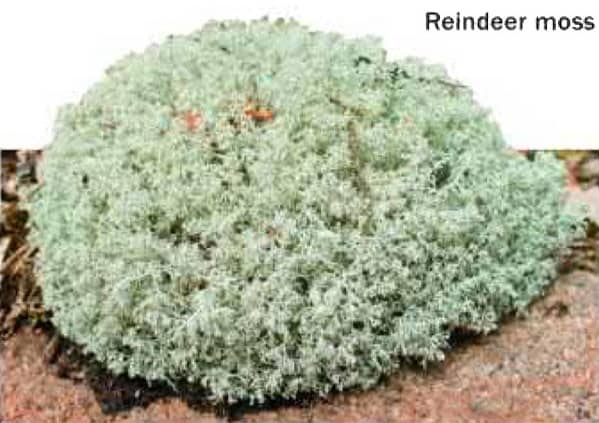 — In Iceland, the Cetraria islandica, the well known Iceland moss is used as a source of food for sheep and cattle as well as for human beings. For use as food, the lichen is soaked in a weak solution of sodium or potassium to neutralise the lichen acids, dried and then powdered. The powder, when boiled in water, yields a jelly which is eaten with milk.
— In Iceland, the Cetraria islandica, the well known Iceland moss is used as a source of food for sheep and cattle as well as for human beings. For use as food, the lichen is soaked in a weak solution of sodium or potassium to neutralise the lichen acids, dried and then powdered. The powder, when boiled in water, yields a jelly which is eaten with milk.
— Everina is used for making bread, Lecanora is also edible. Other edible lichens are Lecanora esculenta and Umbilicaria esculenta. In India (Bellary district of Madras), some species of Parmelia perlata (Rock flower or Chabilla) are used as curry powder.
— A desert lichen, Endocarpon miniatum is used as a vegetable in Japan.
► As Medicine
— Peltigera canina (the dog-lichen) is used to cure hydrophobia.
— Certain lung diseases are cured by Lobaria pulmonaria. Evernia furfuracia is used to treat cough.
— Usnic acid obtained from Usnea and Cladonia is used as an antibiotic component of ointment for burns and wounds. Because usnic acid has antibiotic properties against a number of fungi and bacteria, including human pathogens. Indeed, they are used in commercially available antiseptic creams.
— Parmelia saxatilis is used in epilepsy.
— Usnea barbata is used for uterine disorders.
— Xanthoria parietina is used to treat jaundice.
— Cetraria is used as a laxative.
— The protolichesterinic acid, obtained from some lichen like Cetraria icelandica, has anticarcinogenic properties.
► Tanning and Dying
Lichens are deeply pigmented. They may be blue, green, yellow, orange, red, brown and grey in colour. Gyrophora is white.
— Cetraria islandica and Lobaria pulmonaria are used as tanning agents in the tanning industry.
— Lecanora, Rocella, Parmelia, Evernia etc., are dye yielding (orchil) lichen species. It is also used for dyeing woollens and silks.
— Litmus (a pH indicator) is obtained from lichen Roccella montaignei.
— Orcein (a chromosomal stain) is a purified product of orchil.
► Miscellaneous Uses
— Certain perfumes are extracted from Evernia prunastri and Lobaria sp.
— Ramalina and Evernia are used in “Havan Samagri” and in the manufacture of soap.
— In Russia and Sweden, some lichens like Cetraria islandica and Cladonia rangiferina are used for alcoholic fermentation.
— Certain organic acids, like lacanoric acid, usnic acid, are also obtained from lichens. The growth of Neurospora crassa is inhibited by usnic acid.
— Crustose lichens are pioneers in xerosere (succession beginning in dry condition).
— Lichens are sensitive to sulphur dioxide pollution. A decrease in the lichen population of an area is indicative of air pollution.
► Harmful Aspects
—The lichens grow on cemented walls, marble, window panes and cause damage due to the secretion of acids.
— In the hot season, Usnea may produce forest fires.
— Arctic lichens are known to cause skin rashes in Eskimos.
— Some lichens are poisonous also due to various substances present in them as:
Lichen Poisonous due to
Letharia Vulpina
Vulpinic acid
Cetraria juniperina
Pinastrinic acid
Parmelia molluscula
Selenium
Xanthoria parietina
Beryllium
Everina furfurcea (tree moss)
Chlorine


